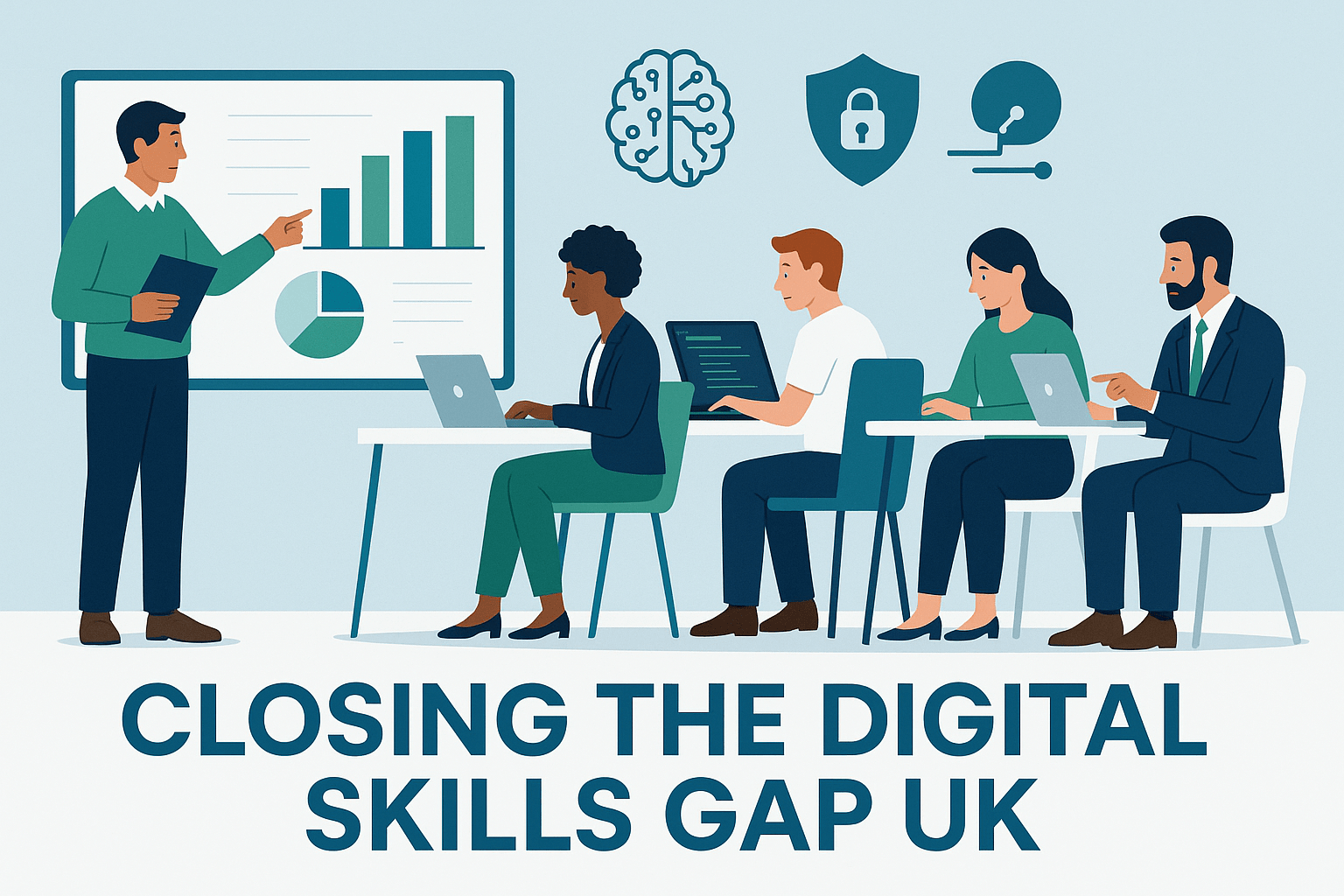When I started teaching and designing online training programmes more than 15 years ago, the digital world was far simpler. Learning Microsoft Office or basic IT support was considered a competitive advantage. Fast forward to today, and the UK is grappling with something much bigger: a digital skills gap.
Employers urgently need staff who can code, analyse data, secure networks, and manage digital workflows. Yet millions of UK workers still lack these skills. The digital skills gap UK faces is not just a tech issue—it affects productivity, job security, and even the country’s competitiveness on the global stage.
In this article, I’ll explore:
- What the digital skills gap looks like in the UK.
- The cost of inaction for individuals and businesses.
- Practical strategies for upskilling.
- Real-life examples of learners closing their own gaps.
- How online courses and government programmes can help.
Understanding the Digital Skills Gap UK
What the Data Says
According to the House of Commons Digital Skills Briefing (UK Parliament), nearly 70% of UK digital workers say they want more training, but 93% cite barriers such as cost or time. The economy loses an estimated £63 billion a year due to this shortage of digital skills.
Which Skills Are Missing?
Employers consistently highlight shortages in:
- Data Analytics & Business Intelligence
- Cybersecurity Awareness
- Cloud Computing & Digital Infrastructure
- Coding & Software Development
- AI Literacy and Automation
Why Closing the Digital Skills Gap Matters
For Individuals
The gap puts workers at risk of falling behind. Those without up-to-date digital skills may find their roles automated or outsourced. On the other hand, those who invest in skills gain higher salaries, more opportunities, and job security.
For Businesses
A digital skills shortage slows innovation. Companies waste resources on inefficiencies and risk losing competitiveness. Research shows that companies with digitally skilled teams grow faster and adapt more easily to market shifts.
For the UK Economy
Without addressing the gap, the UK risks falling behind nations that invest heavily in digital transformation. The government has already committed funds through initiatives like TechFirst (£187m) (TechRadar) to strengthen AI and digital learning across education and workplaces.
Strategies to Close the Digital Skills Gap UK
1. Government Programmes
- Skills Bootcamps – provide free/subsidised training in digital skills.
- T Levels – give school leavers technical qualifications.
- Apprenticeships – combine work and technical training.
These programmes offer structured entry points for learners of all ages.
2. Flexible Online Certifications
For working adults, flexibility is key. Online certifications let learners upskill without quitting their jobs. For example:
- Microsoft Power Automate: Complete Beginner to Advanced – helps professionals automate repetitive tasks.
- Linux Command Line Mastery – strengthens IT and DevOps capability.
- Data Visualisation in Python – a practical skill employers value in analysts.
3. Employer Partnerships
Employers can invest in training, creating internal academies or partnering with providers. This allows staff to learn skills tailored to the company’s needs while staying in their roles.
4. Project-Based Learning
The most effective upskilling strategies combine certifications with practical projects. Building a chatbot, automating a workflow, or creating a data dashboard makes skills tangible and job-ready.
Case Study: From Customer Service to Cybersecurity Analyst
One learner I worked with, Ahmed, was in a customer service role. He worried about automation replacing parts of his job. Instead of waiting, he enrolled in a cybersecurity Bootcamp, supplementing it with an online Cyber Security for Absolute Beginners.
Within a year, he transitioned into an entry-level cybersecurity analyst role. Not only did his salary increase, but his career became future-proof, as cybersecurity demand continues to grow.
Overcoming Barriers to Upskilling
Time
Most learners struggle to find time. Microlearning—10–20 minute lessons—helps integrate training into daily routines.
Cost
While some certifications can be expensive, government-backed Bootcamps and affordable online platforms make upskilling accessible.
Confidence
Many adults feel intimidated by tech. Starting with beginner-friendly courses (like Introduction to Python Programming) can build confidence step by step.
My Experience: Lessons from 15+ Years
In my years of teaching, I’ve seen professionals transform their lives by bridging their digital gaps. From retail staff who became data analysts, to office managers who automated workflows and saved their teams hours weekly, the outcomes are inspiring.
The pattern is clear: those who invest in digital skills progress, while those who hesitate risk being left behind.
Conclusion
The digital skills gap UK faces is one of the biggest challenges—and opportunities—of our time. For individuals, closing it means higher wages, job security, and career growth. For businesses, it means productivity and innovation. For the UK, it’s about maintaining competitiveness in a digital-first world.
The good news is that solutions are here. Government Bootcamps, flexible certifications, and practical project-based learning make upskilling achievable for everyone.
👉 Start closing your own skills gap today: Skill Development & Technical Skills



0 responses on "Closing the Digital Skills Gap: UK Workforce Upskilling Strategies That Work"